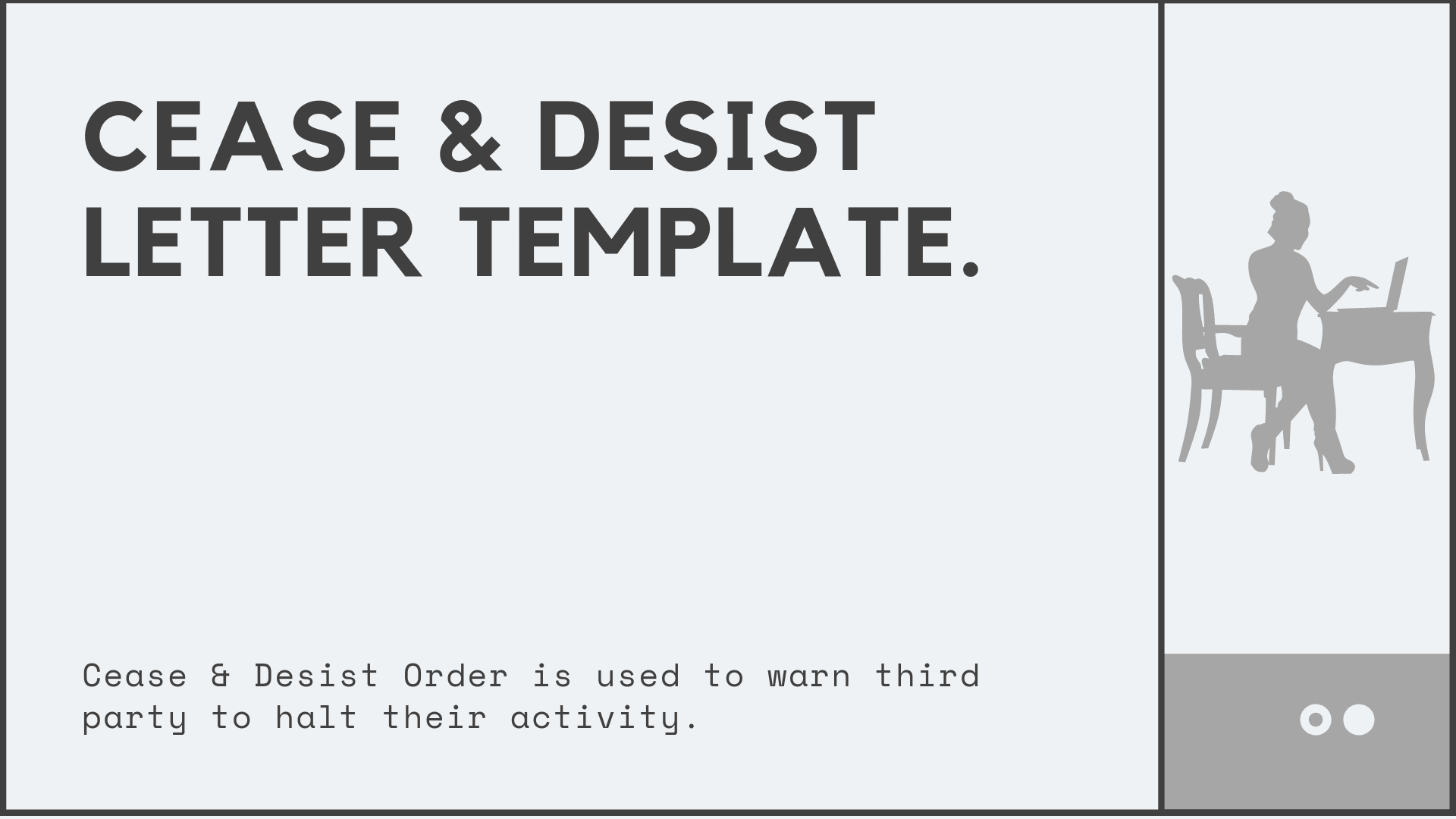Cease and Desist Order information and Template
Cease and Desist Order template

A cease and desist order are given when a court or a government agency forces a company or person to end a certain objectionable or illegal activity that it is carrying out. It is basically a court or an individual person’s warning order against them. These orders can be used to stop a company or person from engaging in unfair activity (“Cease”) and warn them not to restart it (“Desist”), else the sender of cease and desist order reserves the right to sue the recipient.
A cease and desist order can be defined as follows:
- With the objective of stopping someone from certain activity
- To warn someone to put a halt on a certain activity
- In order to stop someone else from doing something.
What is the meaning of a cease and desist order?
The cease and desist order is a legal letter sent to a business or an individual in order to purportedly warn them to put a halt on any activity (“cease”) and not to restart it again (“desist”). The letter of cease and desist order also warns the recipient about the legal proceedings and possible consequences, in case, the recipient does not stop the activity within the given time. Otherwise the sender of cease and desist letter reserves the right to sue the recipient.
The cease and desist order may be requested by the injured person before a court and with the objective of achieving that, certain companies or persons, cease and dismiss their activity. This is a temporary suspension of the activity. After the suspension, the corresponding trial will begin in order to know if the prohibition will be permanent. After the hearing, the court will decide the issue.
A practical example might be A public figure who learns that she will be defamed in a book that is about to be released. Therefore, he or she may apply for a cease and desist order, in order that the book not be published. Subsequently, the corresponding trial will begin to determine whether the order will stand or not and whether the book is harmful or not.
Why people send cease and desist letters?
With the intention of accelerating the ban and resolving the situation as quickly as possible, people can send a cease and desist letter to the person or company carrying out the illegal activity. These letters serve as a threat to those companies or individuals who engage in illegal activities. If a person has a provisional patent for a product and learns of a company’s intention to launch a very similar product, they can send this letter. Another example might be a corporation trying to prevent a former employee of yours from divulging company secrets.
Negative aspects of cease and desist letters
Many people see these letters as a way to intimidate people who are unfamiliar with the law. People often understand this because the letter details that the person is involved in illegal activity and that, as a result, the person may suffer severe consequences. In reality, the letter is a simple negotiation tactic. However, in some situations it may mean one of the following:
- Establish a notification: Its purpose is to warn the defendant so that later he cannot claim ignorance of the situation.
- Extortion: If the letter details threats of harm to the other person, this can be taken as blackmail or extortion.
- Permission to sue as a result of a declaratory judgment: If the threat to sue the other party is based on a violation of the law that is not such, then the recipient of the letter may bring civil actions against the sender of the letter. This situation may also result in a defamation complaint.
Why should we avoid a letter of cease and desist?
Although the letters are used for several reasons, in particular, they all point to the same thing: That the company or person, stop performing the illegal activity. The most common situations for this type of letter are:
- Harassment: If we are demanding harassment, we must include the date on which the harassment began and a detailed description of the rejected actions.
- Copyright Infringement: The letter can be used to protect material that is blocked by copyright. If it is being used illegally, we can block its use. The product in question must be detailed along with documentary evidence and a story detailing the infringement.
- Trademark Infringement: The letter must include the design of the trademark that is claimed to be infringed and the date on which the trademark was claimed to have been infringed.
- Debt Collection: The letter can be used to stop a collection company from using its tactics to pursue and induce a person to pay. It should detail the account details, outstanding balance, and documentation that can serve to prevent harassment.
As a general rule, when the person receives the letter, they have between 10 and 15 days to evaluate it and decide what the legal step will be. If we send the letter via email, we will certainly reduce the defendant’s response time considerably. If we do this, we must make sure to save all the e-mail exchanges we have had.
What is the letter of cease and desist models?
The models of the cease and desist letter can be found easily on the Internet. They are not at all difficult to complete and prepare. The cease and desist template is also available at the end of this article download section. The basic information to be included will be:
- General and contact information of the sender of the letter.
- General information and contact of the company or person who will receive the letter.
- Date of the day.
- Details of the actions to be stopped.
- The detail that demands the total stop of illegal actions.
- Warning that more legal action will be taken if the action continues.
- A deadline for responding to the lawsuit. It is usually between 7 and 10 days.
Whenever the letter is sent, it is a good idea for it to be accompanied by an affidavit or, if using e-mail, for the signature to be certified.
How can a cease and desist order be obtained?
The way to get order will be by filing another type of legal action in addition to the letter. The legal action that must be taken will depend very much on the infraction that has been committed. If the order is for harassment, we will most likely first have to apply for a restraining order against the person. If this happens, you should ideally contact a lawyer.
Some legal terms related to ceasing & desist letters
- Injunction: Order preventing the performance of an activity by a company or person.
- Libelous: Written and defamatory statement.
- Defamation: A false statement made in an attempt to damage someone’s reputation.

